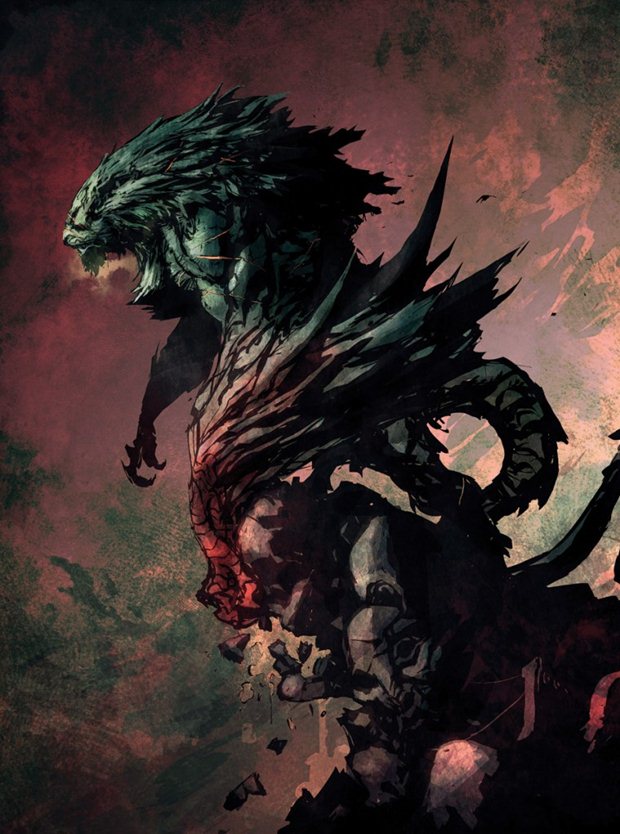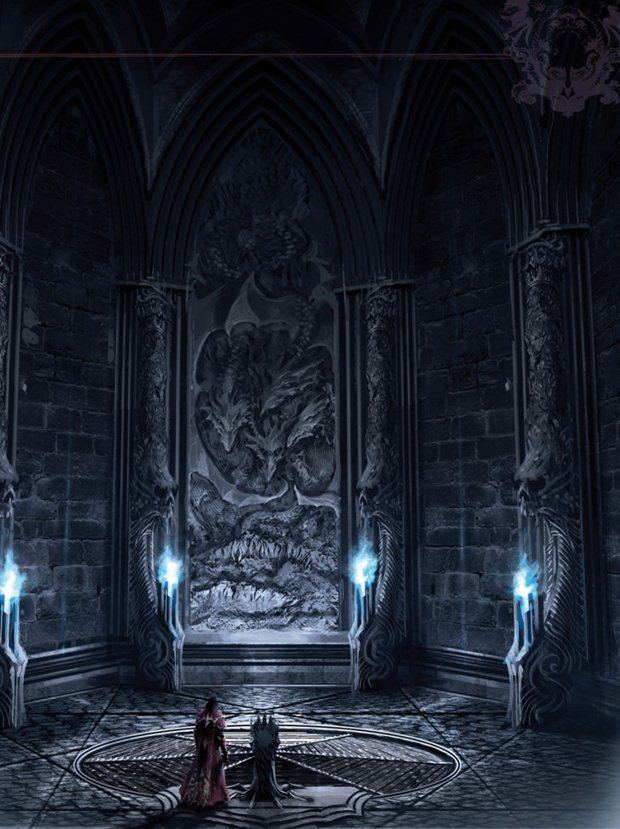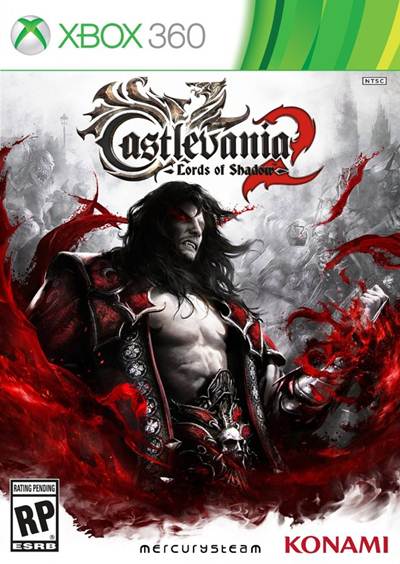
Walking on a darker path much different to what was originally released back in 1986, Castlevania The Lords of Shadow has evolved the series in much the same way that Mercury Steam has evolved the character of the Prince of Darkness himself. The passion and guided narrative that takes you through the Art of Castlevania delivers on what the studio set out to accomplish through the Lords of Shadow series, and while the original game was far more credited for being closer to the original series while at the same time breathing new life into the world, and providing an origin story to the game’s main villain. Going into the book headfirst before approaching the Lords of Shadow sequel, the illustrations, concepts, and ideas that’s printed onto the pages largely outweigh the game.
The Art of Castlevania introduces itself with a foreword back-story of a child growing up in the 1980s spending all his cash on videogame arcade machines. Little did he know that one game in particular would largely be responsible for his input later on in life towards the Castlevania franchise. This game was known as “Haunted Castle”. This small piece of information carried both a sense of irony and destiny, and taking a few moments to think on the subject I discovered a personal feeling of inspiration.
"Progressing onwards and discovering more about Gabriel, the illustrations that follow manage to capture both the feeling of immersion and excitement that the Lords of Shadow game did well in accomplishing. Falling in line much to the same manner of the game, the pages that present Gabriel seemed to get darker and darker with each page I turned."
This small segment of a child’s personal attachment that formed the chain of events that would lead up to the creation of Castlevania The Lords of Shadow felt like it was destined to happen, better yet, inevitable. Juan Antonio Alcazar Redondo’s goal for an immersive world that would touch and form a bond between the player and the game continues down the page to pay respect for his colleges and his love for the series. With every page bound in artwork with none left untouched the passion is evident.
The book itself divides itself up into chapters ranging from character concepts and back stories followed by environments, enemy bosses, and character weapons. With the first 32 pages split between the game’s main protagonist as Gabriel Belmont and Dracula, it’s clear that the effort taken to fully fledge out this character’s transformation into a bloodlust nightmare of a fallen hero was truly thought out. Gabriel’s history on his loyalty to the Brotherhood is shown to be a main feature within his own personal design, that would reflect both his visual appearance as well as his personality and his in-game animations.
The illustrations tell their own story on the type of man that the studio has envisioned for the game, and while the artwork speaks for itself you’re given a better understanding of the character through directive text. Progressing onwards and discovering more about Gabriel, the illustrations that follow manage to capture both the feeling of immersion and excitement that the Lords of Shadow game did well in accomplishing. Falling in line much to the same manner of the game, the pages that present Gabriel seemed to get darker and darker with each page I turned.
"The Descent of a Man falling into the darkness that would later on down the line be responsible for the hatred that would exist between Father and offspring was as touching as it was amazing"
The Descent of a Man falling into the darkness that would later on down the line be responsible for the hatred that would exist between Father and offspring was as touching as it was amazing. “We wanted him to be Dracula from the beginning”. After reading this line by Alvarez it became more apparent to me of just how much Castlevania is as much a story of tragedy, love and sadness, as it is a nightmarish horror.
The latter is introduced on the upcoming pages with one of the most monstrous and important pieces of text within the entire book, one that would solely define the difference between Gabriel and Dracula. “There’s no room for such lightness in Lords of Shadow, where the tragedy of Gabriel Belmont is reflected in a more solemn, melancholy light, its Dracula wallowing forlornly in the dark. It’s a more serious depiction, crafted for a more serious tale.
Ranging from concept illustrations that bare something similar to the characters seen in Marvel comic’s Blade, all the way up to something more bone chilling such as 1992’s Bram Stoker’s Dracula, it was clear that forming the balance between creating something that’s as dangerous as it is frightening, while giving the player a feeling of power when experiencing the game was a crucial factor in the depiction of Dracula.
"In what seems to cover the majority of the book and for good reason, the locations and environments remain as crucial to the Castlevania series as human blood remains to Dracula. Taking influence from European folklore as well as real life locations, this section of the book is really surprising as to how and where the research comes in for designing such an important part of Castlevania."
In the early stages of the Lords of Shadow 2 game, the player is introduced to a more weakened and frail character, one that also possesses a feeling of being dangerous and a serious threat. This appearance of a broken and sorrow man is almost worth feeling sorry for, and the book portrays this well. His rejuvenation however of a larger, violent, and by his name’s sake immortal creature, is what follows with its various depictions of Dracula’s Dragon transformation.
While they may not be playing center role of the book or not even be as detailed as the Prince of Darkness, the concepts and illustrations taken to the Belmont family play an important role within the game. The rebuilding and reinventing of Character’s such as Trevor, Simon, and Zobek are emphasized in every form seen throughout the series. Trevor’s fate much similar to that of his Father’s may not be as touching or as troubling, but the downfall that plagued both Father and Son is presented through the book in a manner that still remains as disturbing as the game’s history. Trevor’s descent into a monster of opposite preferences to that of Dracula’s is present through his many concepts.
In what seems to cover the majority of the book and for good reason, the locations and environments remain as crucial to the Castlevania series as human blood remains to Dracula. Taking influence from European folklore as well as real life locations, this section of the book is really surprising as to how and where the research comes in for designing such an important part of Castlevania. The time spent designing the locations in the original Lords of Shadow appears to be more varied and interesting compared to its sequel, and further to that of the handheld titles.
The take on darkened fairy tales brought to life by mystical forests, geared clock towers, and the ruined corridors of Dracula’s castle are all designed in relation to the player’s expectations aswell as the studio’s vision. The design research applied to the platform that the game is played on was also an important aspect of the design, as the book not only covers the main game’s in the series, but also that of the environments seen in Castlevania Mirror of Fate. “Working with a side-on perspective and with a camera that freely scaled in and out of the action, Mirror of Fate has fun with a sense of scale.”
"The Art of Castlevania Lords of Shadow is a book that manages to capture both the spirit of the studio that originally created the series as well as the studio that re-imagined and reinvented it for the modern age."
Reading through the book and studying the concepts of the game’s environments, there’s a sense of “I’ve been there and I’ve fought that before”. The amazing feeling of immersion given by the two-dimensional perspective of art within the book is as exciting as the game’s themselves. While the feeling taken towards the book remains difference due to change in medium, the experience that this book delivers feels like you’re revisiting the Castlevania story, assuming you’ve journeyed through the previous games.
The connection that remains between the handheld title Mirror of Fate to that of the larger scale console games are interesting in the fact that while Mirror of Fate is designed and experienced on a two-dimensional scale, the European and medieval influence that merges the games together are prominent throughout the many pieces of illustrations that the book presents. In the many videogame art books I’ve had the pleasure of reading, never have I seen such a marvelous transference of an illustrative concept to a fully fleshed out series of games in both two-dimensional and three-dimensional form.
Diving through literally every foe, villain, and antagonist to make their way into the story. The supernatural beasts, witches, lycans, and vampires you encounter within the games are as devastating within concept as they are within their designs and influences. If there’s one thing that links all the enemies of the series together it’s the feeling of constant threat, wrapped in a cloak of dark nature, while some foes retain their iconic characteristics and appearance throughout the entire series, such as the ghouls.
The design decisions to creatures such as the vampires and the titans have evolved with the series and taken on new appearances more in-line with that of the game inwhich they appear. As many would have no doubt questioned Mercury Steam’s character inspirations of the titans that you do battle with in the first Lords of Shadow game, Alvarez states in the book it’s out of respect to what he sees as one the past decade’s greatest games. “They’re an homage to a Team Ico game, Shadow of the Colossus”
The Art of Castlevania Lords of Shadow is a book that manages to capture both the spirit of the studio that originally created the series as well as the studio that re-imagined and reinvented it for the modern age. The menacing concepts of Dracula and Alucard as well as the gigantic environments that the game allows the player to explore is well realized within the book, and the energy that carries the immersion and emotion that the player feels towards the game, also exists within this book. Die-hard fans of the series would do well in journeying through its many pages, and casual fans with any interest of the series or vampire folklore will enjoy it all the same.


















